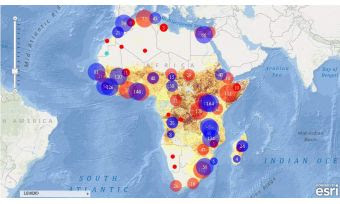Geographic
information systems (GIS) has become a well-known term all over the
world due to its rapid growth all through from the time it had its
roots. You might want to have the meaning of the GIS itself but as it
has the sounding, it just has the simple meaning of a tool. As
questions arise on how and why GIS, there has been its growth and the
impact of its development all over the world. In the Easter African
Region, there has been the development of GIS and has had a great
impact to the economy and its people.
Geospatial
information systems has taken a greater role in the planning sector
in the Easter African region. It has had its introduction in many
planning agencies in east Africa. Urban planners find GIS to be
effective tools that can help in information management, processing,
dissemination and communication. Initial evidence and the
implementation of GIS technology in local governments and planning
agencies points to difficulties in getting the systems established
and realizing expected benefits. Technological, database and
organizational factors make it most challenging to get a GIS to fit
and adapt to needs of planning practice. The main sources of evidence
to find the mutual adjustment between GIS technology and planning are
evaluative studies of existing systems that examine how this GIS
affect planning processes and functions.
GIS
has had the impact in the health sector in East Africa. A good
example is the application of GIS by the Non-Governmental
organization known as The World Vision. It has had its accessibility
in the location of all the areas to have their helping schemes.
Through multivariate spatial statistical modeling of disease
processes GIS has improved the health sector in all the East African
countries by evaluating potentially disease outbreaks and a more
effective allocation of sparse remedial resources towards their
containment and prevention.GIS has also assisted users in better
understanding the potential harmful effects of environmental
pollutants such as toxic waste sites and even in understanding the
occurrence of pedestrian and other injuries and crimes.
The
agricultural sector has been effected through the introduction of GIS
in the Eastern African region. Geospatial technologies are essential
for the routing and scheduling of delivery and collection vehicles,
for keeping track of the distributed assets of utilities, for
improving agricultural production through precision agriculture, and
for managing cutting and silviculture in forestry operations. In
government, they are essential in support of planning,
data-gathering, and assessment.
Geospatial
technologies have greatly increased the ability of individuals in
East Africa to see what is happening in their own neighborhoods and
around the world. Many local communities are employing geospatial
technologies to help them understand and manage their own
neighborhoods, raise awareness of potential problems, and engage with
planning authorities. This have an inclusion of the disaster
management strategies and their remedies.
The
ability of GIS to overlay existing data with new information and
display it in color on a computer screen is used by east African
countries primarily to conduct analysis and make decisions related to
geology, ecology, land use, demographics, transportation and other
domains most of which relate to the human use of physical environment
so GIS is a modern tool that is now readily available and usable.
This feature has given the ability to involve the East African
countries the opportunity to give an overview about their geological
aspects.
GIS,
through geocoding has made it easy for east Africa to get heights of
points such as mountains. GIS has helped many of the East African
countries have their street addresses converged in one database and a
location of each done in a simple way. Indexes of recognized features
such as rivers or lakes also exist, allowing properties associated
with such features to be positioned in latitude and longitude; and in
East African countries there are recognized systems of formal
coordinates such as national grids. One of the great successes of
geospatial technology in recent years has been in making it almost
trivially easy, cheap, and reliable to convert between these
alternative systems of geographic referencing, and to embed these
features in countless Web services. The general public in the Region
uses these services, often without being aware of their inherent
sophistication, in such daily activities as finding the locations of
points of interest such as stores or hotels, acquiring driving
directions, or planning travel.
 |
| Climate Change impacts and Political Stability Map. Courtesy of ESRI |